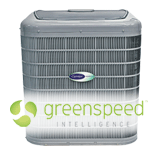OPTIMAL COMFORT
Air conditioning is something everyone appreciates on a hot or humid day. Most Bay Area homeowners operate their furnaces more than their air conditioners but air conditioning is no longer a luxury to be enjoyed by just a lucky few. The installed price of central air conditioning has become very affordable.
For optimal health and comfort, relative humidity levels should range from 30 to 50 percent in the winter and 40 to 50 percent in the summer. Sustaining humidity at these levels usually requires mechanical assistance from a furnace or air conditioner.
Air conditioners can cool, dehumidify and filter room air so it is cleaner and more comfortable. They are usually placed in the same location as a home’s furnace and share the same air-flow ducts used by the furnace although they can be placed in differing locations.

HOW CENTRAL AIR CONDITIONERS WORK
A System can be installed to cool an entire house or only specific zones.
Every air conditioner contains a condenser with coils, an evaporator with coils and a compressor. The condenser and compressor are typically located together outdoors. The evaporator is more commonly located inside the house where it shares the same air handling unit (blower, etc.) used by the home’s forced-air furnace. It can however be placed outside the home with the condenser and compressor.
When a central air conditioner operates it pulls hot room air through air ducts to an evaporator. The evaporator usually contains coiled copper tubing with a refrigerant locked inside the tubing.
An air handler pushes hot indoor air across evaporator coils. Cold refrigerant circulates through the coils and absorbs heat from the air and turns it into heated vapor.
The heated vapor moves through copper tubing to an outdoor compressor where it is pressurized. The pressurized vapor moves through the condensing coils and with the aid of a fan expels the refrigerant’s heat into the atmosphere. The temperature of the refrigerant rises and lowers as it absorbs and expels its heat. It changes from liquid to vapor and then back to liquid as its temperature and pressure change. The entire process is a continuous circulation of heated vapor and refrigerated liquid.
SELECTING THE RIGHT AIR CONDITIONING SYSTEM
It is important that an air conditioning system be the right size for your house. An air conditioner that is too large will diminish your comfort by turning itself on and off too frequently and do a poor job of dehumidifying your indoor air. An air conditioner that is too small cannot keep up with the load requirements demanded of it on a hot day and therefore will not adequately cool your home or building to the desired temperature.
Manufacturers build air conditioners in many models and sizes but their capacity to cool is typically measured in “tons” or “BTU’s) per hour.” This is a unit of measurement used for measuring heat output. It is equal to the amount of energy that is require to raise one pound of water one degree Fahrenheit. One ton equals 12,000 BTU’s per hour. It is the amount of energy required to melt 1 ton of ice in a day.
AIR CONDITIONER – ENERGY EFFICIENCY
The US Department of Energy establishes minimum efficiency standards for central air conditioners. Every unit must be assigned a SEER efficiency rating (Seasonal Energy Efficiency Rating) by the manufacturer. The rating is usually displayed on a yellow Energy guide label that is placed on each unit. The higher the SEER number – the more energy efficient the unit is.
The minimum SEER rating allowed by DOE for new central air conditioners as of January 2006 was 13. More efficient air conditioners have SEER’s of 17.
PROGRAMMABLE THERMOSTATS
Programmable thermostats help air conditioners meet higher efficiencies by enabling more precise control. Fans that stay on long enough to utilize remaining residual cool air after the compressor turns off assist in saving energy. Regularly scheduled maintenance and changing of filters also increases energy efficiency.
OTHER CONSIDERATIONS AFFECTING ENERGY EFFICIENCY
The balancing of air-flow in and out of rooms, duct adequacy, room size, climate conditioners and how well your home is insulated are all factors that are taken into consideration by our design team. Our experienced experts can determine and recommend the right system for your unique requirements.
Carrier Central Air Conditioners, Carrier®
Carrier is the largest manufacturer and distributor of heating, ventilating and air conditioning (HVAC) systems in the world. They are a subsidiary of United Technologies Corporation.
Carrier knows air conditioning. After all, they invented it—and they’ve been perfecting it for over a hundred years. Carrier’s advanced Infinity™ Series offers the highest efficiency, while Carrier’s Performance™ and Comfort™ Series products provide economical efficiency and complete comfort.
Infinity® Series Air Conditioners
Performance™ Series Air Conditioners
Comfort™ Series Air Conditioners
CALL ANYTIME FOR INFORMATION, CATALOGS & PRICING
We can create a customized home comfort system tailored to your needs with our broad selection of heating and cooling products, including Carrier’s BASE Series products. We can help you choose the optimal system for your home to further enhance your indoor environment.
SAN FRANCISCO SF BAY AREA – AREAS SERVED
San Mateo County
Atherton, Belmont, Brisbane, Burlingame, Colma, Daly City, Palo Alto, Foster City, Half Moon Bay, Hillsborough, Menlo Park, Millbrae, Pacifica, Portola Valley, Redwood City, San Bruno, San Carlos, San Mateo, South San Francisco, Woodside
Alameda County
Alameda, Albany, Berkeley, Castro Valley, Dublin, Emeryville, Fremont, Hayward, Kensington, Livermore, Mount Eden, Newark, Oakland, Piedmont, Pleasanton, San Leandro, San Lorenzo, Sunol, Union City
Contra Costa County
Antioch, Brentwood, Clayton, Concord, Danville, Lafayette, Martinez, Moraga, Oakley, Orinda, Pittsburg,
Pleasant Hill, San Ramon, Walnut Creek
Santa Clara County
Campbell, Cupertino, Gilroy, Los Altos, Los Altos Hills, Los Gatos, Milpitas, Monte Sereno, Morgan Hill, Mountain View, Palo Alto, San Jose, Santa Clara, Saratoga, Sunnyvale
Marin County
Belvedere, Corte Madera, Fairfax, Greenbrae, Kentfield, Larkspur, Mill Valley, Novato, Ross, San Anselmo, San Rafael, Sausalito, Tiburon
San Francisco County
San Francisco















